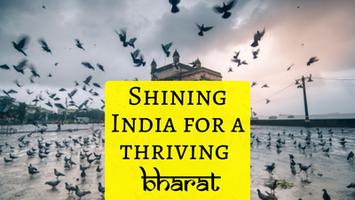Why we shouldn't tamper with Indus water treaty
- By
- Anand ke saath
- November-02-2016
“Panchhi, Nadiya, Pawan ke jhonke, Koi sarhad na inhe roke”
These words from a popular song from the Indian movie, Border, suitably reminds us of nature’s limitless boundaries. In the aftermath of Uri attack in Kashmir however, we are bent upon reviewing the terms of Indus river treaty brokered by the World bank, with Pakistan with some sections of the society even asking to revoke it. None other than Indian PM has said, blood and water can’t flow together.
Whether we shed each other’s blood or not, river shall continue to flow on its own, uninterrupted, as long as we remain sane. No matter if it crosses any Line of control, or no control in the same way. The river systems are above all mundane differences that we may have had, create or run a strife for. Let the Governments of the day be reminded that tampering with the natural flow of these rivers may do permanent damages to their basins.
Out of Six rivers covered in this treaty the major share (80%) of three western ones, Indus, Chenab and Jhelum, are allocated to Pakistan and that of three eastern ones, Ravi, Sutlej & Beas, are allocated to India. India has the option of building more dams upstream of the three rivers and using the water resource for power generation or irrigation purposes, for which there is a limit defined in this treaty. Therefore by building more dams upstream of these rivers that flow into Pakistan, India can technically control the flow of the three rivers. However, it is easier said than done.
The Baglihar dam built over Chenab in spite of various rounds of negotiations with Pakistan remained mired in controversy with Pakistan reaching out to the World bank several times during its construction. It was finally cleared by both Parties in 2010 only. Gestation period of dam projects is large, stakes are high and Investment required is huge. Naturally, in order to be even a part of an offensive response to Pakistan, dams with Water storage, will take a long time (a decade and more), to come to reality. About 10 of these dams on the five rivers and their tributaries, of Punjab have either been built or under construction in the state of J & K. Majority of these dams are of Run-of the- river type, implying having no water storage as India is bound by the treaty.
Possibly the only other immediate offensive that India can exercise is revival of Tulbul dam project, that has remained on the drawing board owing to Pakistan’s objections since early 80’s. This dam was proposed to be built as “navigation lock-cum-control structure" at the mouth of Wular Lake. One major objective of the project was to maintain draught of 4.5 feet (1.4 m) in the river up to Baramulla during the lean winter months by controlling release of Jhelum water into the lake. This would have helped Indian side maintain navigation possibility in Jhelum throughout the year. Pakistan contests this referring to the treaty as it fears Indian control over Jhelum.
Being downstream Pakistan runs the risk of either facing severe drought or floods. However, at the same time it could be equally damaging for India as well to attempt to control the flow of these six river systems. Exercising any such control on the flow, would also require building mammoth storage capacity on our side. We would therefore be much better off keeping away from tampering with these rivers or be ready to face floods on our side.
Also, we must not forget we have similar treaties with other neighbors, Nepal, Bangladesh and China. China & Nepal sit upstream of a few rivers that flow into our land. Any such attempt could seriously jeopardize our relationship with other neighboring nations.
Recent war mongering seen over Indian media after Uri attack might be a wonderful ploy to divert attention from much pressing needs of the nation, we should nevertheless think with heightened prudence & care, and must not get carried away. Any such war converting into a Water conflict shall have serious damages on both sides.
The frequent call of support from Pakistan for the Pro Azadi supporters in Jammu & Kashmir can’t get more misplaced in the context of present times. The entire so called Pro Azadi movement rests upon a purported Religious-cultural plank that is plagued by a rigid & static interpretation of Two Nation theory. The political parties on both sides of LOC have historically indulged into milking the popular jingoistic sentiments of people at large, resulting in a perpetually tensed & violent environment.
Such is the madness prevailing for decades in valley, as if freedom from the Government of India is going to change the fortunes of the people and they will reclaim their paradise lost. They need to introspect harder what Azaadi would mean for them, what they stand to gain. Definitely there are numerous sets of so called stakeholders who have benefited from the underlying belly occupied by corrupt negotiators. These people would continue to benefit from status quo as long as all three parties-India, Kashmir & Pakistan don’t budge from their respective position.
On the other hand, nature has blessed the Valley with its world famous meadows, orchards of apple, pear, nuts and almonds, pastures and lakes. The people of Kashmir must determine first what to do with what have they been bestowed with.
It speaks volumes of the rising misery of the state when not even one City has been selected for India’s 100 smart cities mission. The life in Valley is paralyzed, economically broken and in dire need for urgent repair. The prevailing curfew for more than 3 months now has broken the backbone of economy of J & K, i.e. Tourism. Schools & colleges have been kept shut, some of them even been burnt.
Neither the Land nor the people of J & K deserve such misery. Any blow over Indus water treaty is bound to have hugely negative impact over J & K and its people.













